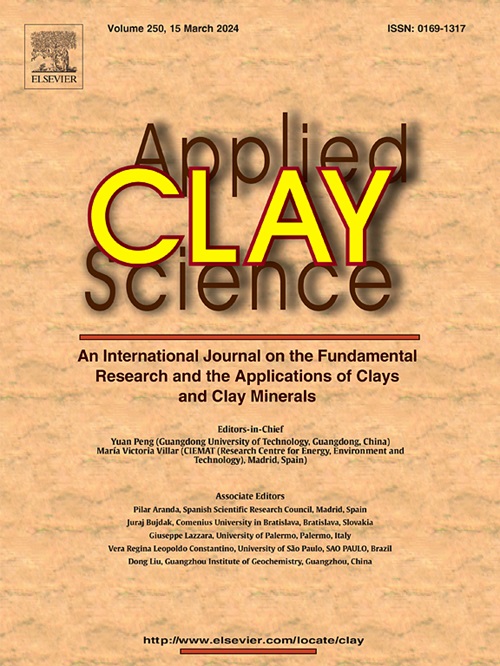Sorption mechanism of europium(III) onto metakaolin-based geopolymers
IF 5.3
2区 地球科学
Q2 CHEMISTRY, PHYSICAL
引用次数: 0
Abstract
Metakaolin-based geopolymers (MKGPs) are ceramic-like materials used for nuclear waste stabilization. Therefore, understanding the sorption of ions on MKGPs is crucial where the cation exchange is considered as the main mechanism, yet the studies based on pH are limited. Thus, this study evaluates the effect of pH on the sorption mechanism of Eu(III) onto Na- and K-MKGPs. Here, time-resolved laser fluorescence spectroscopy (TRLFS) combined with parallel factor analysis, TRLFS in mixed D2O/H2O matrices, and extended X-ray absorption fine structure analysis. Eu(III) predominantly forms surface complexes with both MKGPs in the pH range of 4–11 at the open air environment, where three distinct surface species were identified at different pH values. The Eu(III) sorption mechanisms of both MKGPs are similar, involving ternary edge-sharing bidentate or monodentate inner-sphere surface complexation of Eu(III) with MKGP and silicate ions released from the MKGP up to pH 8, followed by the precipitation of Eu(OH)3(S) within the pores of MKGP. The insights gained from this study will enhance the knowledge on MKGP for pollutant immobilization, thereby mitigating the spread of contaminants in the environment and expanding the potential application areas.
铕(III)在偏高岭土聚合物上的吸附机理
偏高岭土聚合物(MKGPs)是一种类似陶瓷的材料,用于稳定核废料。因此,了解离子在MKGPs上的吸附是至关重要的,其中阳离子交换被认为是主要机制,但基于pH的研究是有限的。因此,本研究评价了pH对Eu(III)在Na-和K-MKGPs上吸附机理的影响。本文将时间分辨激光荧光光谱(TRLFS)与平行因子分析、混合D2O/H2O基质中的TRLFS以及扩展的x射线吸收精细结构分析相结合。在4-11的露天环境中,Eu(III)主要与这两种MKGPs形成表面配合物,在不同的pH值下鉴定出三种不同的表面物质。两种MKGP对Eu(III)的吸附机理相似,均为三元共边双齿或单齿Eu(III)与MKGP的内球表面络合,MKGP释放出的硅酸盐离子达到pH 8,随后在MKGP的孔内沉淀Eu(OH)3(S)。从本研究中获得的见解将增强对MKGP污染物固定化的认识,从而减轻污染物在环境中的传播,扩大潜在的应用领域。
本文章由计算机程序翻译,如有差异,请以英文原文为准。
求助全文
约1分钟内获得全文
求助全文
来源期刊

Applied Clay Science
地学-矿物学
CiteScore
10.30
自引率
10.70%
发文量
289
审稿时长
39 days
期刊介绍:
Applied Clay Science aims to be an international journal attracting high quality scientific papers on clays and clay minerals, including research papers, reviews, and technical notes. The journal covers typical subjects of Fundamental and Applied Clay Science such as:
• Synthesis and purification
• Structural, crystallographic and mineralogical properties of clays and clay minerals
• Thermal properties of clays and clay minerals
• Physico-chemical properties including i) surface and interface properties; ii) thermodynamic properties; iii) mechanical properties
• Interaction with water, with polar and apolar molecules
• Colloidal properties and rheology
• Adsorption, Intercalation, Ionic exchange
• Genesis and deposits of clay minerals
• Geology and geochemistry of clays
• Modification of clays and clay minerals properties by thermal and physical treatments
• Modification by chemical treatments with organic and inorganic molecules(organoclays, pillared clays)
• Modification by biological microorganisms. etc...
 求助内容:
求助内容: 应助结果提醒方式:
应助结果提醒方式:


